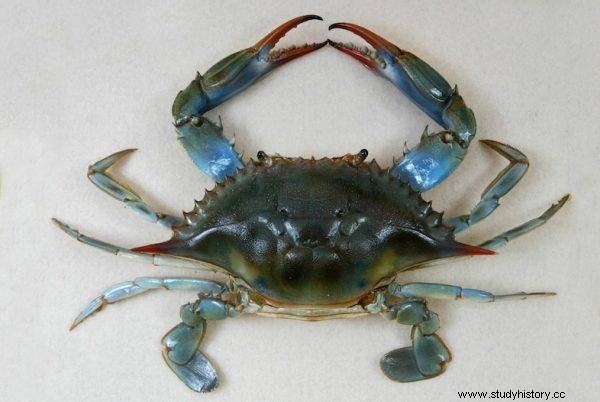In the Yellow Sea, a sea border called the Northen Limit Line was established after the Korean War. It was violated by both Korean states for many years. Reason? Blue Kalinka, inconspicuous blue crab. It is so valuable that it was profitable to sacrifice the life of soldiers for him ...
After the Korean War, the United Nations established the Northen Limit Line to protect North Korea from attacks by South Korea. The Republic of Korea, ruled by Rhee Syngman, did not recognize the truce because it did not sign such a document.
The border line runs very close to the mainland territory of North Korea for the sake of the Yeonpyeong island archipelago belonging to the Republic of Korea. In the surrounding waters there is a lot of blue crab - the main character of this story.
For two decades, both sides adhered to the designated sea border. The situation changed only in 1973, when North Korea began to demand that the archipelago be returned and a new border should be designated . The demands were not complied with and the matter quieted over time until 1995, when the DPRK officially announced that it did not recognize the Northen Limit Line.
Meanwhile, the blue crab's population grew so much that its catches began to be of great economic importance. North Korea, through the Nothen Limit Line, has very limited fisheries for this valuable crustacean practically along its shores. In order to increase the possibility of fishing for the blue viburnum, she decided to fight for the waters in the Yellow Sea.
First crab battle
The border was notoriously violated - once the northern ships entered the waters of the South, and sometimes the southern ones - into the waters of the North. June 6 did not stand out in this respect. North Korean ships crossed the Northen Limit Line. South Korea decided to send its patrol units in their direction to "push" unwanted guests . The scuffle damaged four Northern and three Southern ships. The tension grew, but everyone waited - no one wanted to be the one to start.
The crew of one of the North Korean ships could not stand the pressure. The sailor directed the fire of his machine gun at the South Korean unit, and after a while the on-board 25 mm guns joined the fire. Republic of Korea ships did not remain in debt. They responded with 76mm cannons and 20mm six-barreled cannons. The Republic of Korea won the battle for the hunting grounds. North Korea has suffered a disastrous defeat. She lost 30 sailors, one torpedo ship, and four of her patrol ships were damaged. South Korea lost 9 soldiers and five of its ships were damaged.

Kim Jong Il propaganda announced the great success of the DPRK in the battle with the South
The battle started by North Korea did not bring the expected results. The clash at sea exposed the weakness of the DPRK navy. The Northern Border Line remained unchanged. It is true that Kim Jong-il propaganda announced the great success of the DPRK in the battle with the South. However, the provocation did not go unnoticed. In early September 1999, Dear Leader issued a special announcement annulling the Northen Limit Line and adding that North Korea would defend its territorial waters - including those surrounding the Yeonpyeong archipelago with the most crabs - by military means.
Second try
Until 2002, there were regular incidents in the Yellow Sea, mainly of crab fishing in the neighboring territory. In June 2020, their frequency increased significantly. On June 27, 12 South Korean cutters crossed the Northen Limit Line. As there was no response from the North, 30 boats crossed the border the next day. On June 29, 50 fishing boats escorted by four patrol ships entered DPRK territorial waters. But even that didn't provoke North Korea.
The clash only took place when two South Korean ships tried to block the way south of two North Korean ships escorting several fishing boats. It's hard to say who started the firefight - the Democratic People's Republic of Korea did so according to the Republic of Korea, but the Democratic People's Republic of Korea has never confirmed or denied this information.

The female of the blue calyx
This time, North Korean ships were better prepared. They were armed with large-caliber artillery, which sunk one of the patrol ships of the Republic of Korea, killing five sailors and wounding 22. The losses of the North are unknown. After the clash, it was only noticed that one of the North Korean ships burst into flames.
Winning doesn't always equal win
The Democratic People's Republic of Korea should be considered the victorious side in the second crab battle. However, this win did not bring her any benefits. The Northen Limit Line continues as it was established in 1953.
Additional consequences of the battle were canceled visits by South Korean representatives to North Korea and the complete suspension of the direct telephone line between Korean leaders . Perhaps the biggest blow to North Korea was the suspension of wheat supplies. The "Communist Paradise" has suffered from great food shortages since the 1990s.
Blue Kalinka ended up in the waters of the Yellow Sea by a complete accident. He came stowaways on ships from the west coast of the United States. What a coincidence that the worst opponents of the United States of America are engaged in battles over something that comes from it.
